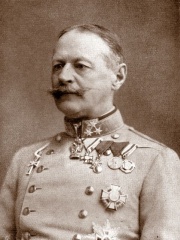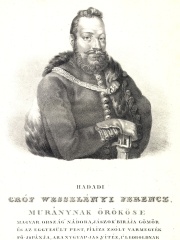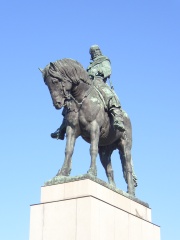
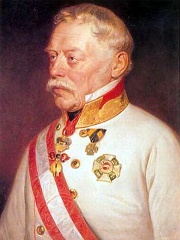
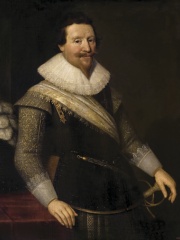
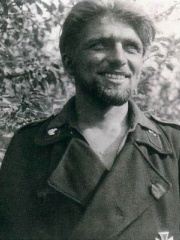
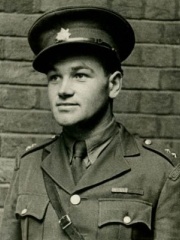
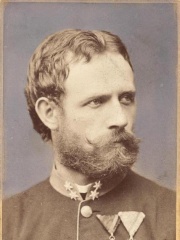
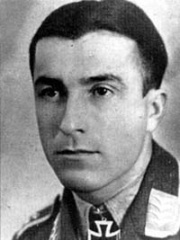
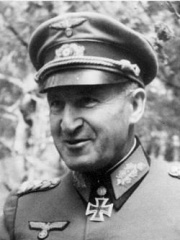
The Most Famous
MILITARY PERSONNELS from Czechia
This page contains a list of the greatest Czech Military Personnels. The pantheon dataset contains 2,058 Military Personnels, 13 of which were born in Czechia. This makes Czechia the birth place of the 19th most number of Military Personnels behind Croatia, and Israel.
Top 10
The following people are considered by Pantheon to be the top 10 most legendary Czech Military Personnels of all time. This list of famous Czech Military Personnels is sorted by HPI (Historical Popularity Index), a metric that aggregates information on a biography's online popularity. Visit the rankings page to view the entire list of Czech Military Personnels.

1. Jan Žižka (1360 - 1424)
With an HPI of 80.33, Jan Žižka is the most famous Czech Military Personnel. His biography has been translated into 48 different languages on wikipedia.
Jan Žižka z Trocnova a Kalicha (English: John Zizka of Trocnov and the Chalice; c. 1360 – 11 October 1424) was a Czech military leader and knight who was a contemporary and follower of Jan Hus, and a prominent Radical Hussite who led the Taborite faction during the Hussite Wars. Renowned for his exceptional military skill, Žižka is celebrated as a Czech national hero. Žižka led the Hussite forces in battles against three crusades and remained undefeated throughout his military career. Žižka was born in the village of Trocnov, located in the Kingdom of Bohemia, into a family of lower Czech nobility. According to Piccolomini's Historia Bohemica, he maintained connections within the royal court during his youth and later held the office of Chamberlain to Queen Sofia of Bavaria. He fought in the Battle of Grunwald (15 July 1410), where he defended Radzyń against the Teutonic Order. Later, he played a prominent role in the civil wars in Bohemia. He led the Hussites during the first important clashes of the conflict in the Battle of Sudoměř (1420) and in the Battle of Vítkov Hill (1420). In the Battle of Kutná Hora (1421) he defeated the army of the Holy Roman Empire and the Hungarian Kingdom. The effectiveness of his field artillery against the royal cavalry in this battle made it a successful element of Hussite armies. Žižka's tactics were unorthodox and innovative and they are today considered examples of early modern guerrilla and asymmetric warfare. In addition to training and equipping his army according to their abilities, he used armored wagons, known as wagon forts, fitted with small cannons and hand cannons, anticipating the tank of five hundred years later. He exploited terrain to a greater extent than was conventional for his time, using terrain reconnaissance, knowledge and manipulation to aid his guerilla tactics and defensive maneuvers at the time when cavalry charges and open field skirmishes were standard practice. His troops were reportedly highly disciplined and loyal, having been recruited from nobility, militias and peasantry alike. His tactics necessitated rapid training for new recruits to face highly trained and armored opponents repeatedly, who usually outnumbered his own troops. According to later writers, Žižka rarely committed his forces to battle unless he had first ensured a strong tactical advantage—often through ambushes, disruption of enemy movements, or use of fortified terrain—greatly increasing the odds of victory despite being outnumbered. For those reasons, Žižka is often regarded as one of the greatest military commanders of all time and his tactics are today studied in military academies worldwide. A monument was erected on the Vítkov Hill in Prague to honor Jan Žižka and his victory on this hill in 1420. It is the third-largest bronze equestrian statue in the world.

2. Joseph Radetzky von Radetz (1766 - 1858)
With an HPI of 77.49, Joseph Radetzky von Radetz is the 2nd most famous Czech Military Personnel. His biography has been translated into 45 different languages.
Johann Josef Wenzel Anton Franz Karl, Graf Radetzky von Radetz (2 November 1766 – 5 January 1858) was a Czech nobleman and Austrian field marshal. He served as chief of the general staff in the Habsburg monarchy during the later period of the Napoleonic Wars and proved instrumental in the allied victory as one of the primary architects of the Trachenberg Plan and the Leipzig Campaign which led to the Battle of Leipzig. Afterwards, he embarked on military reforms of the Austrian army. His reputation was one of discipline and fairness; he was revered by his troops among whom he was known as Vater ('Father') Radetzky. He is best known for the victories at the Battles of Custoza (24–25 July 1848) and Novara (23 March 1849) during the First Italian War of Independence. Johann Strauss I's Radetzky March was commissioned to commemorate Radetzky's victory at the Battle of Custoza.

3. Albrecht von Wallenstein (1583 - 1634)
With an HPI of 76.29, Albrecht von Wallenstein is the 3rd most famous Czech Military Personnel. His biography has been translated into 48 different languages.
Albrecht Wenzel Eusebius von Wallenstein, Duke of Friedland (; 24 September 1583 – 25 February 1634), also von Waldstein (Czech: Albrecht Václav Eusebius z Valdštejna), was a Bohemian military leader, statesman and a major figure of the Thirty Years' War, fighting on the Catholic side as supreme commander of the armies of Holy Roman Emperor Ferdinand II. His successful martial career made him one of the richest and most influential men in the Holy Roman Empire by the time of his death. He is considered one of the most important military leaders produced by the early modern period. Wallenstein was born in the Kingdom of Bohemia into a poor Czech Protestant noble family, affiliated with the Utraquist Hussites. He acquired a multilingual university education across Europe and converted to Catholicism in 1606. A marriage in 1609 to the wealthy widow of a Bohemian landowner gave him access to considerable estates and wealth after her death at an early age in 1614. Three years later, Wallenstein embarked on a career as a mercenary by raising forces for the Holy Roman Emperor in the Uskok War against the Republic of Venice. Wallenstein fought for the Catholics in the Protestant Bohemian Revolt of 1618 and was awarded estates confiscated from the rebels after their defeat at White Mountain in 1620. A series of military victories against the Protestants raised Wallenstein's reputation in the imperial court and in 1625 he raised a large army of 50,000 men to further the Imperial cause. A year later, he administered a crushing defeat to the Protestants at Dessau Bridge. For his successes, Wallenstein became an imperial count palatine and made himself ruler of the lands of the Duchy of Friedland in northern Bohemia. An imperial generalissimo by land, and Admiral of the Baltic Sea from April 1628, Wallenstein found himself released from service in 1630 after Ferdinand grew wary of his ambition. Several Protestant victories over Catholic armies induced Ferdinand to recall Wallenstein, who then defeated the Swedish king Gustavus Adolphus at Alte Veste. The Swedish king was later killed at the Battle of Lützen. Wallenstein realised the war could last decades and, during the summer of 1633, arranged a series of armistices to negotiate peace. These proved to be his undoing as plotters accused him of treachery. Dissatisfied with the Emperor's treatment of him, Wallenstein considered allying with the Protestants. However, he was assassinated at Eger in Bohemia by one of the army's officials, with the emperor's approval.

4. Kurt Knispel (1921 - 1945)
With an HPI of 68.70, Kurt Knispel is the 4th most famous Czech Military Personnel. His biography has been translated into 27 different languages.
Kurt Knispel (20 September 1921 – 28 April 1945) was a German tank commander during World War II. Knispel was severely wounded on 28 April 1945 by shrapnel to his head when his Tiger II was hit in battle by Soviet tanks. He died two hours later in a German field hospital. On 10 April 2013, Czech authorities said that Knispel's remains were found with 15 other German soldiers behind a church wall in Vrbovec, identified by his dog tags. On 12 November 2014, the German War Graves Commission reburied his remains at the Central Brno military cemetery in Brno. He was buried with 41 other German soldiers who died in Moravia and Silesia. Post war popular literature and enthusiast literature often portray Knispel as a leading German “tank ace,” sometimes crediting him with as many as 168 destroyed enemy tanks, on the basis of clean Wehrmacht mythology. Modern studies of the “Panzer ace” phenomenon treat such tallies, including those attributed to figures like Michael Wittmann and Otto Carius with considerable caution, noting that individual kill claims from German sources are difficult to verify and were often inflated in post‑war narratives. Alfred Rubbel, serving in the unit explained that the exact number of Knispel’s tank kills could not be confirmed because the battalion did not use to count destroyed tanks or ascribe them to an individual gunner or tank commander. Knispel's supposed "126 confirmed kills" were extensively portrayed in the second installment (book) of the popular historical fiction series Panzer Aces written by Franz Kurowski. But according to Knispel's superior officer in 503rd Heavy Panzer Battalion when he was a commander, Alfred Rubbel "one of Kurowski's numerous fabrications is the claim that Knispel was nominated four times (unsuccessfully) for the Knight's Cross of the Iron Cross." Rubbel said idiomatically: "The book is a sheer imprudence. What's in there, he sucked out of his thumb. What the quotes he puts in my mouth alone! That can't be right."

5. Prokop the Great (1380 - 1434)
With an HPI of 68.55, Prokop the Great is the 5th most famous Czech Military Personnel. His biography has been translated into 29 different languages.
Prokop the Great (Czech: Prokop Veliký, Latin: Procopius Magnus) or Prokop the Bald or the Shaven (Czech: Prokop Holý, Latin: Procopius Rasus) (c. 1380 – 30 May 1434) was a Czech Hussite general and a prominent Taborite military leader during the Hussite Wars. On his mother's side, he came from a German patrician family living in Prague. Initially, Prokop was a member of the Utraquists (the moderate wing of the Hussites) and was a married priest (having received the tonsure early in life) who belonged to an eminent, partly German-speaking family from Prague. He studied in Prague, and then traveled for several years in foreign countries. On his return to Bohemia, though a priest and continuing to officiate as such, he became the most prominent leader of the advanced Hussite or Taborite forces during the latter part of the Hussite Wars. He was not the immediate successor of Jan Žižka as leader of the Taborites, as has been frequently stated, but he commanded the forces of Tabor when they obtained their great victories over the Germans and Catholics at Ústí nad Labem in 1426 and Domažlice in 1431. The crushing defeat that he inflicted on the crusaders of the Holy Roman Empire at Domažlice led to peace negotiations (1432) at Cheb between the Hussites and representatives of the Council of Basel. He also acted as leader of the Taborites during their frequent incursions into Hungary and Germany, particularly when in 1429 a vast Bohemian army invaded Saxony and the territory of Nuremberg. The Hussites, however, made no attempt permanently to conquer German territory, and on 6 February 1430 Prokop concluded a treaty at Kulmbach with Frederick I, burgrave of Nuremberg, by which the Hussites engaged themselves to leave Germany. When the Bohemians entered into negotiations with Sigismund and the Council of Basel and, after prolonged discussions, resolved to send an embassy to the council, Prokop the Great was its most prominent member, reaching Basel on 4 January 1433. When the negotiations there for a time proved fruitless, Prokop with the other envoys returned to Bohemia, where new internal troubles broke out. A Taborite army led by Prokop the Great besieged Plzeň, which was then in the hands of the Catholics. The discipline in the Hussite camp had, however, slackened in the course of prolonged warfare, and the Taborites encamped before Plzeň revolted against Prokop, who therefore returned to Prague. Probably encouraged by these dissensions among the men of Tabor, the Bohemian nobility, both Catholic and Utraquist, formed a league for the purpose of opposing radicalism, which through the victories of Tabor had acquired great strength in the Bohemian towns. The struggle began at Prague. Aided by the nobles, the citizens of the Old Town took possession of the more radical New Town, Prague, which Prokop unsuccessfully attempted to defend. Prokop now called to his aid Prokop the Lesser, who had succeeded him in the command of the Taborite army before Plzeň. They jointly retreated eastward from Prague, and their forces, known as the army of the towns, met the army of the nobles between Kourim and Kolín in the Battle of Lipany (30 May 1434). The Taborites were decisively defeated, and both Prokops, Great and Lesser, perished in the battle. The fourth rifle regiment of Czechoslovak legions was named after him in July 1917.

6. Jan Kubiš (1913 - 1942)
With an HPI of 67.20, Jan Kubiš is the 6th most famous Czech Military Personnel. His biography has been translated into 24 different languages.
Jan Kubiš (24 June 1913 – 18 June 1942) was a Czech soldier, one of a team of Czechoslovak British-trained paratroopers sent to eliminate acting Reichsprotektor (Realm-Protector) of Bohemia and Moravia, SS-Obergruppenführer Reinhard Heydrich, in 1942 as part of Operation Anthropoid. During the assassination attempt, Kubiš threw a makeshift grenade that mortally wounded Heydrich.

7. Julius von Payer (1841 - 1915)
With an HPI of 64.17, Julius von Payer is the 7th most famous Czech Military Personnel. His biography has been translated into 24 different languages.
Julius Johannes Ludovicus Ritter von Payer (2 September 1841 – 29 August 1915), ennobled Ritter von Payer in 1876, was an officer of the Austro-Hungarian Army, mountaineer, arctic explorer, cartographer, painter, and professor at the Theresian Military Academy. He is chiefly known for the Austro-Hungarian North Pole expedition in 1872–74 and the discovery of Franz Josef Land.

8. Otto Kittel (1917 - 1945)
With an HPI of 63.73, Otto Kittel is the 8th most famous Czech Military Personnel. His biography has been translated into 19 different languages.
Otto Kittel (21 February 1917 – 14 or 16 February 1945) was an Austrian-born German fighter pilot during World War II. He flew 583 combat missions on the Eastern Front, claiming 267 aerial victories, making him the fourth-highest scoring ace in aviation history according to authors John Weal and Jerry Scutts. Kittel claimed all of his victories against the Red Air Force. Kittel joined the Luftwaffe in 1939, and, in spring 1941, he was posted to Jagdgeschwader 54 (JG 54—54th Fighter Wing) supporting Army Group North on the Eastern Front. He received the Knight's Cross of the Iron Cross on 29 October 1943, for reaching 120 aerial victories. During the remainder of World War II, Kittel was credited with 144 more aerial victories and was awarded the Knight's Cross of the Iron Cross with Oak Leaves and Swords. He was shot down by Soviet aircraft and killed in February 1945. Kittel was the most successful German fighter pilot to be killed in action.

9. Erhard Raus (1889 - 1956)
With an HPI of 63.17, Erhard Raus is the 9th most famous Czech Military Personnel. His biography has been translated into 21 different languages.
Erhard Raus (8 January 1889 – 3 April 1956) was an Austrian general in the Wehrmacht of Nazi Germany during World War II. He commanded the 6th Panzer Division during the early years of the war on the Eastern Front before taking army and army group commands. Raus was one of three former Austrians who rose to the rank of Generaloberst (colonel general) within the German Wehrmacht. The other two were Alexander Löhr and Lothar Rendulic.
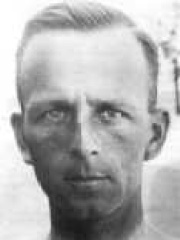
10. Karl Fritzsch (1903 - 1945)
With an HPI of 62.76, Karl Fritzsch is the 10th most famous Czech Military Personnel. His biography has been translated into 17 different languages.
Karl Fritzsch (10 July 1903 – 2 May 1945) was a German SS official who served as deputy and acting commandant at the Auschwitz concentration camp from 1940 to 1941. He is best known as the official responsible for the death of priest Maximilian Kolbe and, according to Rudolf Höss, first suggesting using poisonous gas Zyklon B and experimenting with gas chambers for the purpose of mass murder at Auschwitz. Fritzsch served at a number of Nazi concentration camps until 1944 when he was implicated in a corruption scandal and dismissed from his positions. Fritzsch was sent to front line duty and is believed to have died at the Battle of Berlin on 2 May 1945, but this is unconfirmed, and his fate is unknown.
People
Pantheon has 13 people classified as Czech military personnels born between 1360 and 1921. Of these 13, none of them are still alive today. The most famous deceased Czech military personnels include Jan Žižka, Joseph Radetzky von Radetz, and Albrecht von Wallenstein.
Deceased Czech Military Personnels
Go to all RankingsJan Žižka
1360 - 1424
HPI: 80.33
Joseph Radetzky von Radetz
1766 - 1858
HPI: 77.49
Albrecht von Wallenstein
1583 - 1634
HPI: 76.29
Kurt Knispel
1921 - 1945
HPI: 68.70
Prokop the Great
1380 - 1434
HPI: 68.55
Jan Kubiš
1913 - 1942
HPI: 67.20
Julius von Payer
1841 - 1915
HPI: 64.17
Otto Kittel
1917 - 1945
HPI: 63.73
Erhard Raus
1889 - 1956
HPI: 63.17
Karl Fritzsch
1903 - 1945
HPI: 62.76
Alexander von Krobatin
1849 - 1933
HPI: 61.22
Ferenc Wesselényi
1605 - 1667
HPI: 60.07
Overlapping Lives
Which Military Personnels were alive at the same time? This visualization shows the lifespans of the 9 most globally memorable Military Personnels since 1700.

